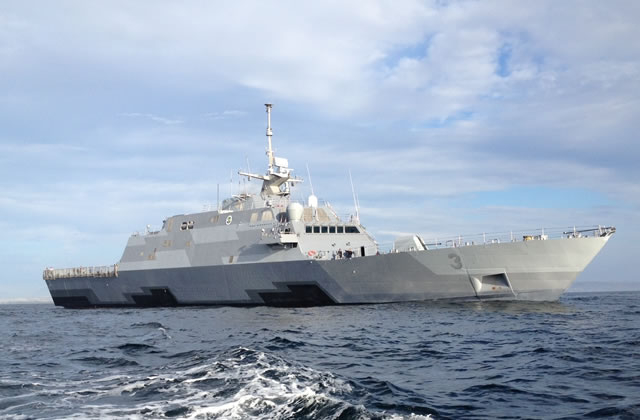| |
|||
| a | |||
Naval
Forces News - USA |
|||
Successful
Factory Acceptance for US Navy Freedom class LCS' TRS-4D AESA Radar |
|||
Airbus Defense and Space, Inc. and its affiliate, Airbus Defence and Space GmbH completed successful factory acceptance testing of the TRS-4D naval radar scheduled to go aboard the U.S. Navy’s Freedom Variant Littoral Combat Ship (LCS) starting with LCS-17. Freedom Variant LCS prime contractor, Lockheed Martin, and US Navy representatives observed the testing. The TRS-4D is an inline upgrade on Lockheed Martin’s remaining ships, starting with LCS-17. |
|||
 USS Fort Worth (LCS 3), Freedom class Littoral Combat Ship Picutre: US Navy |
|||
The TRS-4D
radar for LCS is a rotating version of the Active Electronically Scanned
Array (AESA) fixed panel TRS-4D radar currently going aboard the German
F-125 frigates. Upon installation aboard LCS-17, the TRS 4D will be
the first AESA rotating radar aboard a US Navy ship. This new radar combines mechanical and electronic azimuth scanning to achieve fast generation of target tracks. Additionally, it is a software-defined radar that makes adaptation for future threats and missions very manageable. |
|||
 The TRS-4D radar from Airbus Defense and Space has completed factory acceptance testing and is scheduled to go aboard the US Navy’s Freedom variant Littoral Combat Ship (LCS) beginning with LCS-17. The highly customizable, software-defined radar system supports the planned evolution of LCS to a frigate, and can readily be adapted to change over the service life of the ship. |
|||
System
characteristics of the TRS-4D are an excellent match for the environment
faced by LCS and its evolution to a frigate (FF). The radar’s
AESA technology delivers increased sensitivity to detect smaller targets
with greater accuracy, as well as faster track generation to give LCS
more time to react to advanced threats. This software-defined radar is programmable by the customer, enabling changes to radar characteristics to match future threats that evolve over the life of the ship. The ability to customize the characteristics of the TRS-4D radar enables designers to maximize the inherent modularity of LCS variants to best suit a specific LCS configuration. That customizability will also help enable LCS to evolve through its service life and adapt to evolving required operational capabilities and projected operational environments in a responsive, flexible, and affordable manner. “Superior performance and adaptability for the future are key characteristics of the TRS-4D radar that set it apart from other radar systems,” said Mike Cosentino, President of Airbus Defense and Space, Inc. “It supports the LCS evolution to a fast frigate, meets current and future threats, and can readily be adapted to change over the service life of the ship.” Combining multiple capabilities within a single radar is one way that TRS-4D contributes to the affordability of LCS. Employing state of the art AESA technology, the TRS-4D is a three-dimensional, multi-function naval radar for surveillance, target acquisition, self-defense, gunfire support, and aircraft control. It automatically detects and tracks all types of air and sea targets, alleviating crew workload requirements. LCS affordability is further enhanced by the reliability of the TRS-4D’s solid-state system design, keeping maintenance costs low and further contributing to lower LCS life cycle costs. Littoral combat ships are fast, agile surface combatants optimized for operating in the highly trafficked near-shore regions of the world. Through its innovative modular design, LCS can be reconfigured for surface warfare, anti-submarine warfare, and mine countermeasures in the near term, and adapt its capabilities for changing threats and scenarios that will occur over its service life. Link to Freedom class Littoral Combat Ship technical datasheet |
Successful Factory Acceptance for US Navy Freedom class LCS' TRS-4D AESA Radar
- Posted On










